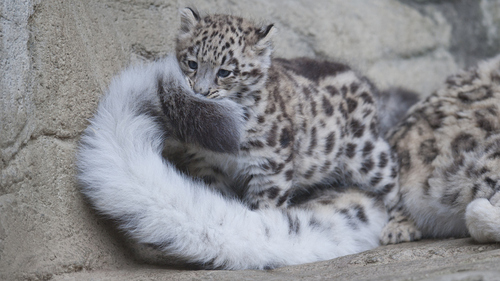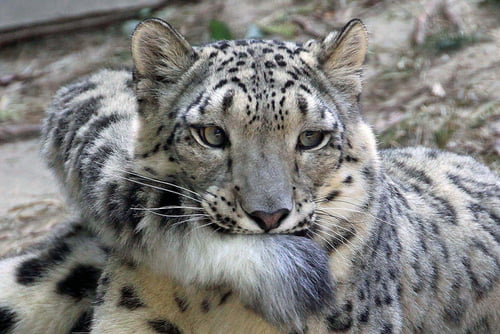Snow leopards do not ‘bite’ their tails to keep their nose warm as has been stated. Neither do they bite their tails in an aggressively harmful way. They don’t even bite their tails. They hold their tails in their mouths because they enjoy doing it as a distracting diversion, as a comforter, or as an act within play. My view is that it is similar to human babies sucking their thumbs. Domestic kittens sometimes suck their thumbs too. The behavior may indicate anxiety.

All the photographs that I have seen of snow leopards biting their tails have been taken in captivity. One of the photographs shows an adult snow leopard ‘biting’ (not really biting) his tail clearly in play. Another photograph shows a snow leopard cub biting the tail of a parent. This will also be in play.


The snow leopard is perhaps the tamest and most gentle of all the wild cat species in captivity. This handsome wild cat behaves somewhat like a domestic cat in captivity.
Quite often in homes, we see domestic cats playing with their tails. The cat’s tail is rather like a cat tease. A cat tease is a feather on a stick which excites a cat. Cats can create their own entertainment with their own tails and the tails of other cats.

I suspect that the adult snow leopard gently holds his tail in his mouth as a vestigial1 act of play and one which is pleasing to the cat.
Here is a video of a subadult holding their tail in their mouth and carrying it in their mouth as they walked. It looks to me as if they are enjoying it and it is as if they find comfort in it as a baby human finds comfort in sucking their thumb.
Humans do many things like this which serve no apparent purpose other than they are pleasant and distracting. We may see snow leopards do this more in captivity because of stress levels. Snow leopards may find the activity reduces stress in much the same way that cats groom themselves because it feels pleasant and in feeling pleasant stress is reduced.

There is nothing in the best books that I have on the wild cats about snow leopards biting their tails. On the internet, there are articles on snow leopards “nomming” their tails. The word “nomming” describes the sound made while chewing on something. The fact is that I do not believe that snow levels chew on their tails. They simply place their tail in their mouth and nibble it perhaps as part of play, as stated.
There may even be a throwback to kittenhood going on: suckling at mother’s nipple. If so this is once again a reassuring pastime.
Note 1: vestigial: a very small remnant of something that was once greater or more noticeable.
Below are some more pages on the magnificent snow leopard.


Thanks Dee and for ‘earning’ 10 cents for an animal charity. 💕👍